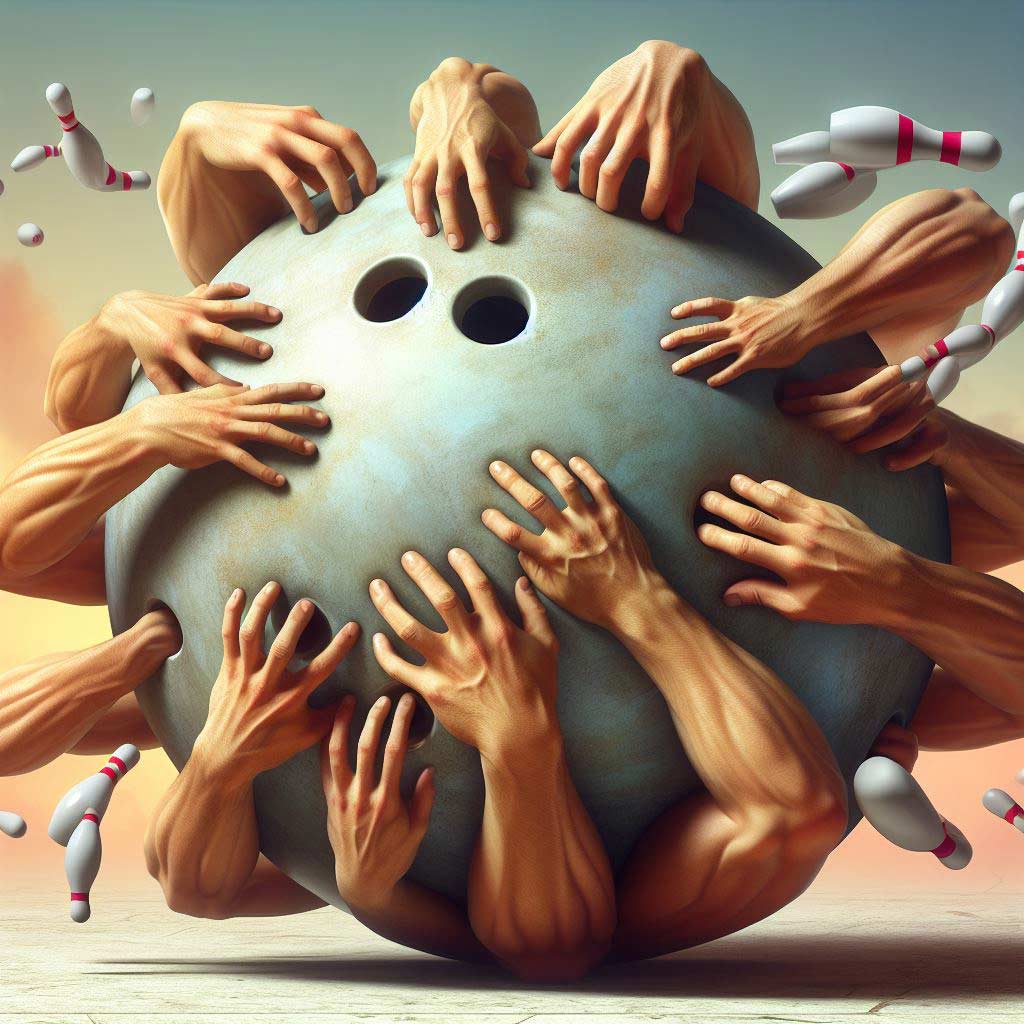As any serious bowler knows, having the right bowling ball setup is crucial for optimizing performance and consistency on the lanes. One aspect that is often overlooked but hugely impactful is the number and configuration of holes drilled into the ball.
The number of holes, their placement, sizing, and shaping can significantly influence how you grip, rev, and release the ball – all key factors in achieving those enviable strikes.
In this definitive guide, we’ll cover everything you need to know about how many holes a bowling ball can legally have according to regulations, the reasons behind the rules, proper hole placements, and options for customization.
By the end, you’ll have a thorough understanding of hole maximums, potential modifications, and how to set up your arsenal for peak performance within the rules.
How Many Holes Can a Bowling Ball Legally Have?
Let’s start with the maximum number of holes permitted by official bowling rules and regulations. According to the United States Bowling Congress (USBC), the global governing body for tenpin bowling, a bowling ball can have no more than 5 holes drilled into it.
Specifically, the USBC equipment specifications state that a bowling ball is allowed a maximum of 3 finger holes and 2 thumb holes. Any more than this 3+2 configuration is considered illegal and the ball cannot be used in sanctioned league or tournament play.
Reasons for Allowing Only 5 Holes
You might be wondering – why is there a 5 hole limit at all? The main reasons come down to maintaining the integrity of the sport, ensuring fair competition, and accounting for proper ball balance and dynamics.
Balance and Weight Distribution
Having too many holes drilled into a bowling ball can negatively impact its weight distribution and overall balance. With an excessive number of holes, the ball’s top/bottom weight block and side weight block get thrown out of acceptable ranges, creating an imbalanced ball that doesn’t track or roll properly down the lane.
Preventing Unfair Advantages
Limiting holes prevents bowlers from trying to gain an illegal advantage through excessive modifications like weight holes or archaic balance hole systems that were banned long ago. Too many holes increases the possibility of undisclosed, unsanctioned alterations that can provide an unfair edge.
Maintaining Integrity of the Sport
Overall, hole limits help uphold the integrity, standards, and level playing field of tenpin bowling globally. By enforcing rules around acceptable ball specifications like hole counts, the USBC and other governing bodies can ensure the sport remains consistent and fair at all levels of play.
Finger Hole Placement and Sizing
With up to 3 finger holes allowed, their exact positioning and sizing is crucial for achieving a comfortable, accurate release. Poor finger hole layouts can negatively impact rev rates, ball motion, and overall control.
Typical finger holes placements account for “span” (the distance between holes) and “pitch” (the angle at which holes are drilled relative to the vertical plane). While specific measurements vary based on the bowler’s hand size and desired ball rotation, there are some standard guidelines:
- Span: Around 4-4.5 inches between holes for most adults
- Pitch: Forward pitches of 3/8″ to 5/8″ are common
- Angles: Holes angled anywhere from 25-45 degrees
Beyond positioning, the diameter of each finger hole is critical as well. Holes that are too tight can causa difficulty inserting and removing fingers, reducing speed and revs. Holes too loose can allow excess ball rotation and lack of control.
Most finger holes range from 7/8″ up to 1″ in diameter, sized precisely to each bowler’s fingers with a snug but not overly tight fit. This custom sizing ensures comfort, feel, and the ability to impart the desired revolutions on each shot.
Thumb Hole Placement and Purpose
In addition to the three finger holes, bowlers can also have up to two thumb holes drilled into their ball. The thumb hole serves a vital role in gripping and accurately releasing the ball, so its placement and sizing are just as important as the finger holes.
Common thumb hole positions include:
- Straight: Drilled perpendicular to the ball’s vertical axis
- Reverse: Angled slightly away from the fingers/wrist
- Oval: An elongated thumb hole to aid release
The thumb hole diameter is typically larger than the finger holes, ranging from 1″ to 1-1/16″ for most bowlers. Having a thumb hole that’s too small can constrict the thumb and limit rom during the swing, while too large increases the chance of sticking the thumb or not releasing cleanly.
Proper thumb hole measurements and fitting are especially critical for hooking the ball effectively. An improperly drilled thumb hole can lead to issues clearing the thumb, inconsistent revs, and poor overall technique.
No-Thumb Bowling Balls
While most tenpin bowling balls feature 3 finger holes and 1 thumb hole as part of the standard grip setup, some bowlers actually choose to go “no-thumb” by drilling their balls without a dedicated thumb hole.
Advantages of a no-thumb bowling ball include:
- Increasing the potential for higher rev rates
- Creating more axis tilt and backend ball motion
- Reducing the chance of a buried/stuck thumb
However, no-thumb also has some key disadvantages:
- Less overall grip and feel of the ball
- Potential for less rev consistency and accuracy
- Increased strain on fingers, wrists, and arms
For skilled bowlers with specific rev rate goals or release styles, no-thumb balls can be an interesting option. But most bowlers, especially those prioritizing control, opt for the standard 3+1 configuration.
Gripping a no-thumb ball requires some technique adjustments. The most common grip is to insert the thumb into the ball at an angle and use the fingers, wrist, and arm to impart revolutions. Release moves like lifting or cupping the wrist can help generate more axis rotation and backend hook.
Plugging and Re-Drilling Holes
Over time, a bowler’s span, pitches, release, and overall fit and feel for their bowling ball often evolves. Maybe they’ve gained weight, worked on increasing rev rate, or developed a new style that requires a different grip. In these cases, having the ability to re-drill existing balls rather than constantly purchasing new ones is hugely valuable.
The process of plugging old holes and re-drilling allows a used ball to be reconfigured and updated to current specs. Here’s a quick overview:
Plugging Old Holes
Professional pro shops use specialized epoxy or wood plugs inserted into existing holes, fortified with adhesives for a permanent seal. This plugging prepares the ball surface to be re-drilled in a new layout.
Re-Drilling Rules and Processes
The USBC and other governing bodies allow up to 1 re-drill of a previously drilled ball under specific provisions:
- No more than 1 plug in each hole
- Plugs cannot exceed 1-1/4″ diameter
- Re-drills must meet current static weight rules
- Re-drill layouts must be recertified
Most pro shops have the machinery and expertise to properly plug, measure, re-drill, and recertify balls that require new layouts. Ensuring the plug is flush with the balls surface and not causing imbalances is critical.
Re-drilling an existing ball saves bowlers money, extends the life of coverstocks and cores, and prevents waste. Just be sure to fully understand your local association’s rules around re-drills for tournament use.
Customizing Hole Sizes and Shapes
While the USBC strictly regulates the overall hole count maximum, there’s a bit more flexibility when it comes to customizing individual hole sizes and shapes within legal limits. Slightly modifying finger and thumb holes can often enhance grip, feel, and revs for certain bowlers.
Increasing Holes Sizes
Some bowlers choose to have their pro shop incrementally increase certain finger hole diameters past the standard 1″ maximum size. This can provide more knuckle clearance for bowlers with thick fingers or those looking to increase potential rev rate. However, holes cannot exceed 1-1/4″ per USBC specs.
Changing Hole Shapes
Additionally, finger and thumb holes don’t have to be perfect circles. Alternative oval, rounded, or rectangular shapes are permitted so long as:
- They don’t exceed the maximum span
- They maintain acceptable weight block ranges
- There are no unconnected/balance holes
The main benefits to customizing hole shapes often include:
- Better fit for odd-shaped knuckles/joints
- Enhanced leverage and release points
- Increased rev potential and axis rotation
- More consistent, controllable revs
However, drastically unconventional or gimmicky hole shapes that violate the spirit of the rules likely won’t pass inspection. Most mods are minor tweaks within USBC parameters.
Consulting the Professionals
While some experienced bowlers may feel comfortable making minor hole alterations themselves, it’s generally advisable to consult a professional certified pro shop operator before modifying holes. They have the knowledge, tools, and certification to ensure any changes comply with all specifications.
Skilled drilling technicians can assess your grip, PAP (Positive Axis Point), rev rate goals, and other specifics to recommend optimal hole sizes and layouts. They can also properly rework existing holes through the plugging and re-drill process.
It’s important to have documentation of any approved ball modifications from the pro shop as well. USBC rules require you to produce certification paperwork verifying the ball meets regulations if there’s ever a question during league or tournament play.
Balancing Rules and Performance
At the end of the day, the hole count limit and specifications around hole shaping exist for legitimate reasons of maintaining fair play and quality of competition. But the rules also allow enough wiggle room for customization to help enhance each bowler’s individual performance.
It’s about striking a balance between squeezing out every possible advantage through optimization, while respecting the spirit and integrity of the sport.
With some creativity from pro shops and an understanding of the reasoning behind the regulations, you can maximize your ball’s hole configuration without crossing any lines.
Knowing your local association’s specific bylaws and equipment rules is critical. What may be allowed in one league may not fly in another. When in doubt, check with a reputable pro shop to ensure your current or modified hole layouts are fully compliant.
Conclusion
There’s a world of knowledge to unpack around optimizing your bowling ball setup – and it all starts with those carefully placed and sized holes.
In this definitive guide, we covered the legal maximums of 5 holes (3 fingers, 2 thumbs) according to USBC standards and the reasons behind the rules including balanced weight distribution and preserving fair play.
We examined proper finger and thumb hole placements, explored no-thumb ball techniques, showed how to update old balls through re-drills, and looked at options for customizing hole shapes and sizes where permitted.
While adhering to regulations is paramount, there’s still plenty of room to tweak and personalize your arsenal to extract more revs, improve fit and feel, and optimize for your specific release and desired ball motion. The key is understanding the fundamentals of holes and their impact, then working within the rules for legal optimizations.
So don’t underestimate the power of those circular (or ovular) holes in your ball! Every last aspect from count to size to positioning can make the difference in achieving a cleaner release, more revs, and maximized performance.
With the right knowledge and some help from a pro shop, you’ll be sending straighter shots with pinpoint accuracy and smashing through more pocket hits in no time.





